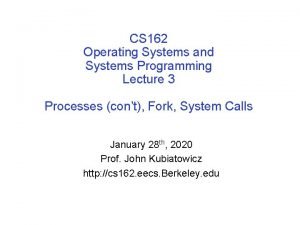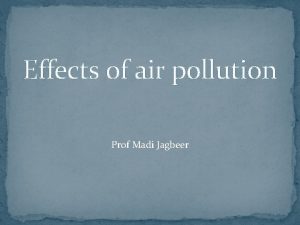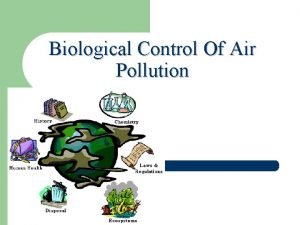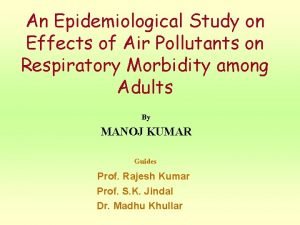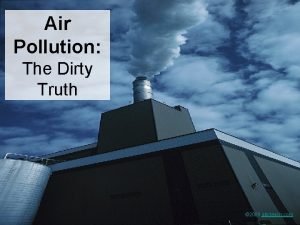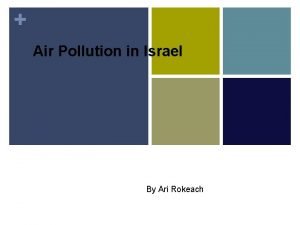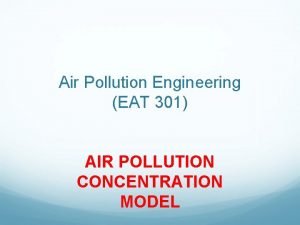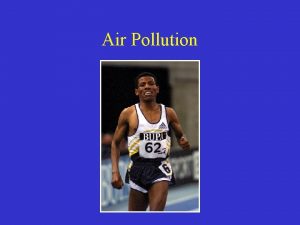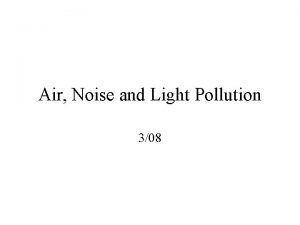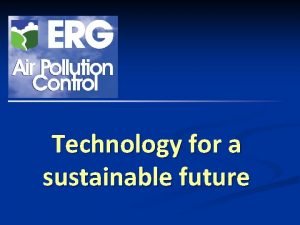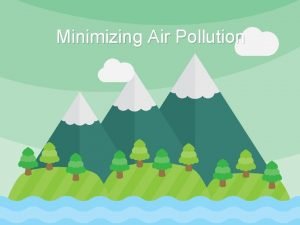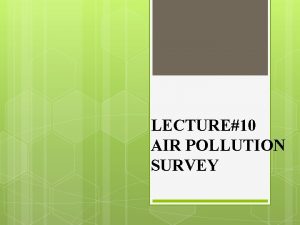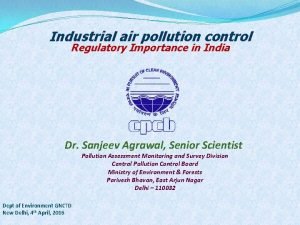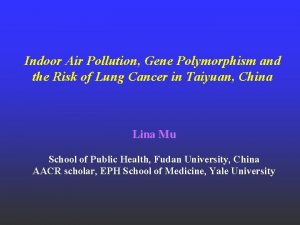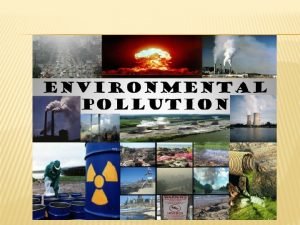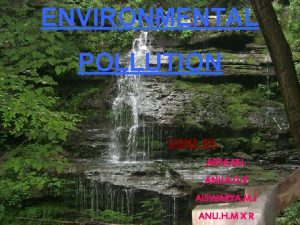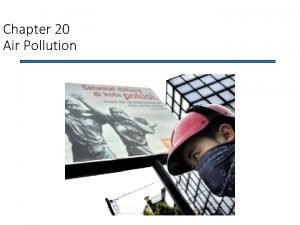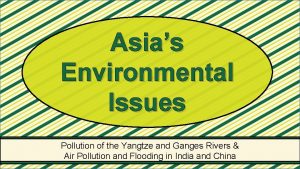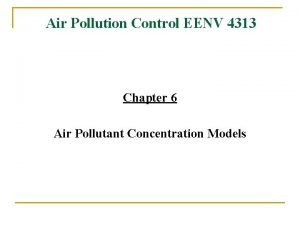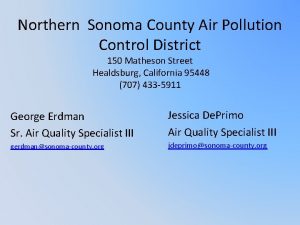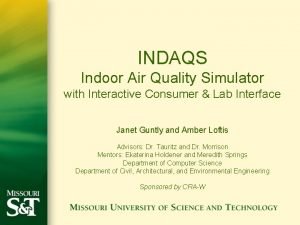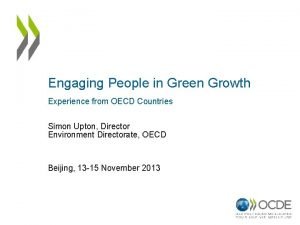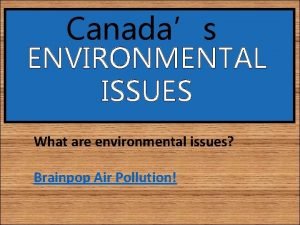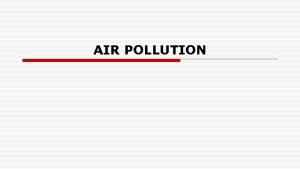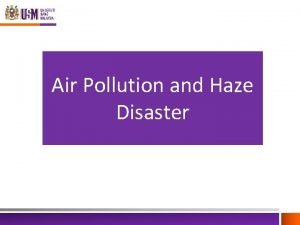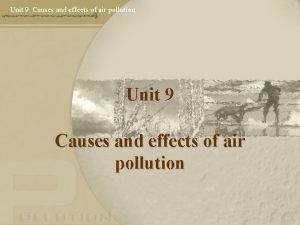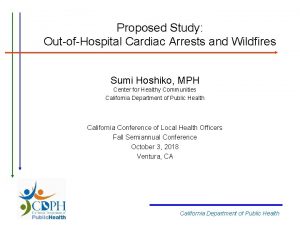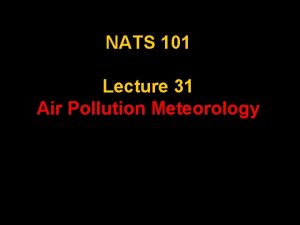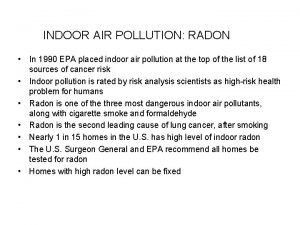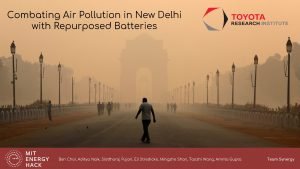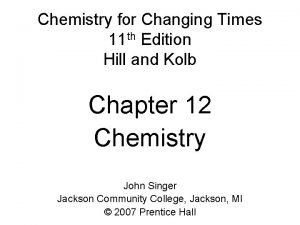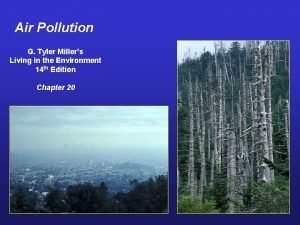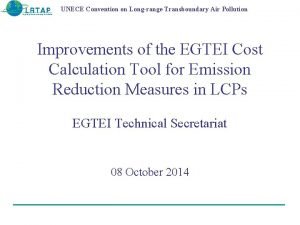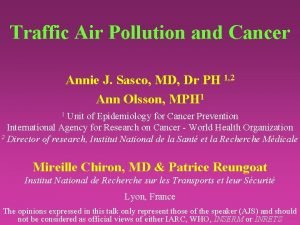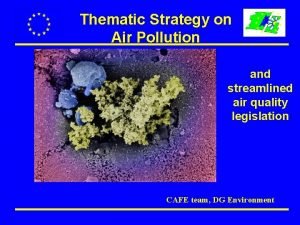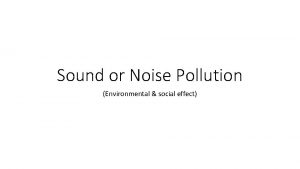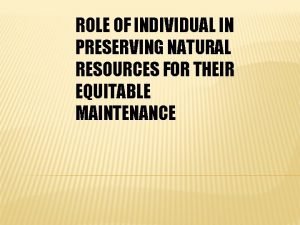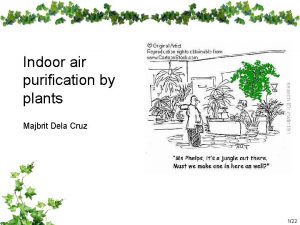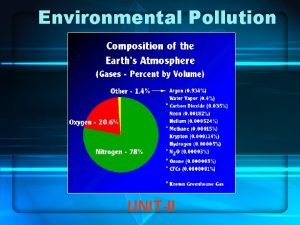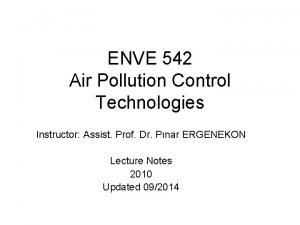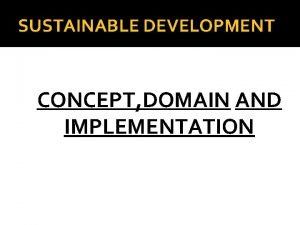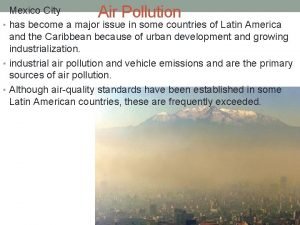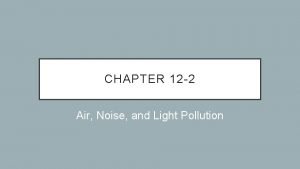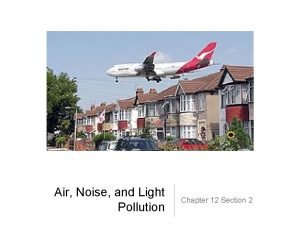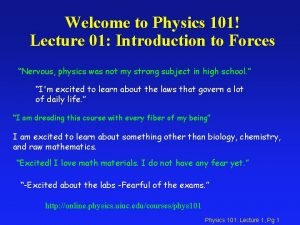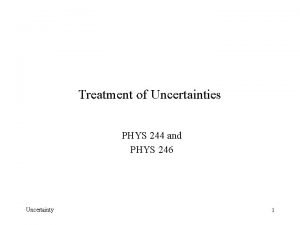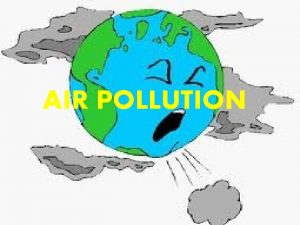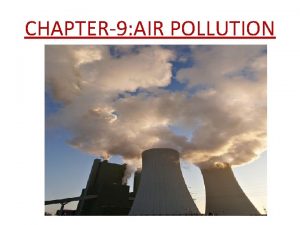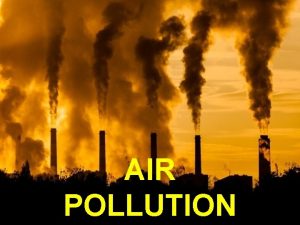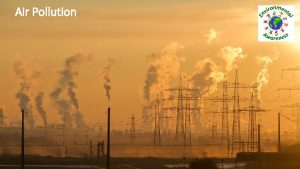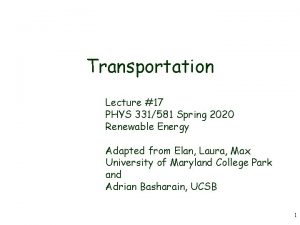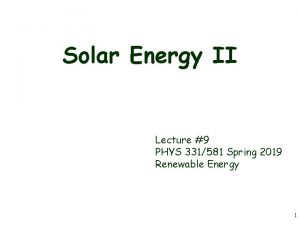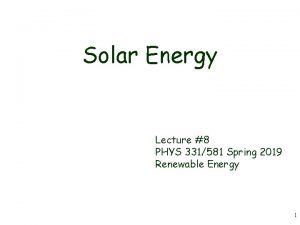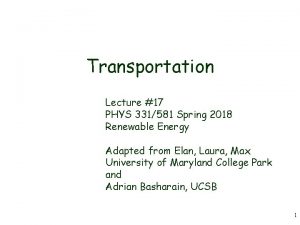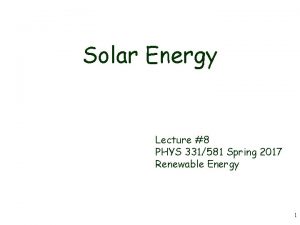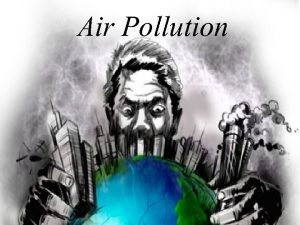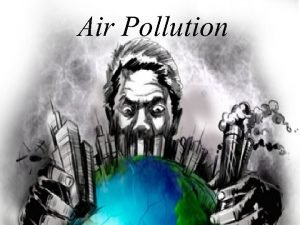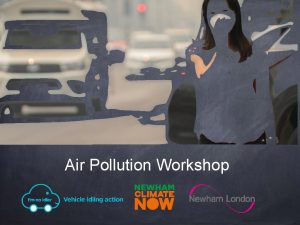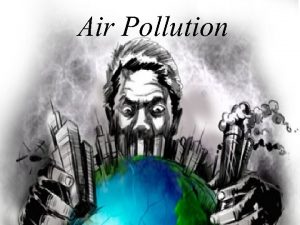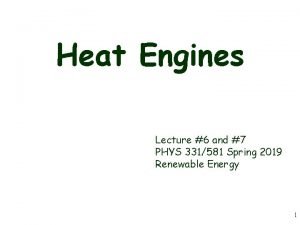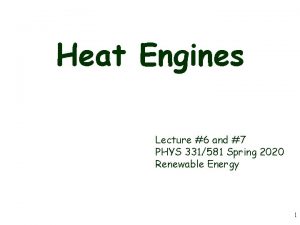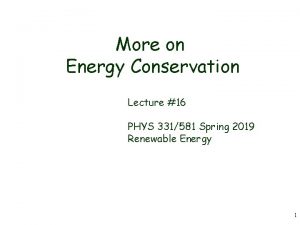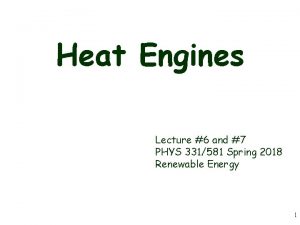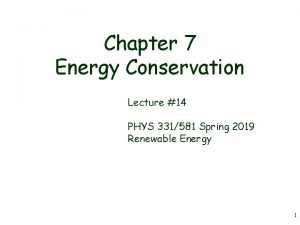Air Pollution Lecture 20 PHYS 331581 Spring 2020




































































- Slides: 68

Air Pollution Lecture #20 PHYS 331/581 Spring 2020 Renewable Energy Adapted from George Mason University, (Geller) and Bergen County Community College 1

Material Overview • • • Earth’s atmosphere Thermal inversions Carbon monoxide Oxides of nitrogen Hydrocarbons and photochemical smog Vehicle emissions Sulfur dioxide Particulate matter Acid rain Air pollution summary 2

i. Clicker Question • Which of the following does not increase fuel efficiency? – A Properly inflated tires – B Proper oil used – C Lower weight of cargo – D Driving faster (>45 mph) – E Lighter weight vehicle 3

i. Clicker Question • In 1800 what was the average time to go from New York to Chicago? – A 1 day – B 1 week – C 2 weeks – D 3 weeks – E over 4 weeks 4

i. Clicker Question • In 1857 what was the average time to go from New York to Chicago? – A 1 day – B 2 days – C 5 days – D 7 days – E 2 weeks 5

i. Clicker Question • What was the major transportation change that lowered the time taken to go from New York to Chicago between 1800 and 1857? – A the development of canals – B the invention of the wheel – C the horse drawn carriage – D the automobile – E the railroad 6

i. Clicker Question • Urban sprawl first occurred after World War II. – A True – B False 7

i. Clicker Question • The automobile has been the major cause of urban sprawl. – A True – B False 8

i. Clicker Question • Daimler invented the automobile. – A True – B False 9

Atmosphere • • • Composition – Nitrogen (78%), Oxygen (21%), Argon, Water Vapor, CO 2, Methane, other Atmospheric Pressure – pressure exerted by atmosphere Warming – Sun - solar constant is not really constant – greenhouse effect v warming due to the transparency of a substance to radiation at visible wavelengths and opacity to infrared radiation 10

The Earth’s atmosphere has changed substantially over time • • • The Earth’s atmosphere differs from those of the other terrestrial planets in its chemical composition, circulation pattern, and temperature profile The Earth’s atmosphere changed from being mostly water vapor to being rich in carbon dioxide A strong greenhouse effect kept the Earth warm enough for water to remain liquid and to permit the evolution of life 11

Structure of the Atmosphere 12

Circulation in atmosphere results from convection and Earth’s rotation Because of the Earth’s rotation, hydrosphere and topography, the circulation in its atmosphere is complex, with three circulation cells in each hemisphere 13

Winds • • Local winds – wind chill factor Global wind patterns 14

i. Clicker Question Which of the following layers of the atmosphere is highest above the surface of the Earth? A Troposphere B Stratosphere C Thermosphere D Mesosphere E Ozone Layer 15

i. Clicker Question What is the primary ingredient of the Earth's atmosphere? A Nitrogen B Oxygen C Nitrogen and oxygen in equal parts D Hydrogen E Carbon dioxide 16

i. Clicker Question In what part of the atmosphere does weather occur? A Hydrosphere B Stratosphere C Ionosphere D Troposphere E All of the above 17

i. Clicker Question How rapidly a planet loses its atmosphere depends on the planet's • I. mass • II. atmospheric composition • III. temperature • IV. rotation period A B C D E I & II III & IV I, II, & III II, III, & IV 18

Hydrosphere • • • Evaporation Humidity Condensation Process – Clouds, fog – Precipitation Size of condensation nuclei and droplet 19

Absolute Humidity 20

Weather Producers An idealized cold front • • Air Masses Fronts Waves and cyclones Storms – thunderstorms , tornadoes, hurricanes An idealized warm front 21

Weather Forecasting • • Predictions based upon – “characteristics, location, and rate of movement of air masses and associated fronts and pressure systems” – Complex computer models Led to science of “chaos” – chaotic dynamic systems Developing thunderstorm cell 22

Climate • • “general pattern of the weather that occurs for a region over a number of years” Major climate regions – tropical – temperate – polar The principal climate zones 23

Ocean currents influence temperatures 24

Distribution of the Water 25

The hydrologic cycle 26

Watersheds of three rivers 27

The path of groundwater 28

Oceanography • • Waves and tides – changes coastal structure v transport of material – long term and short term changes A Climate control mechanism – ocean conveyor belt v major control of climate A wave passing in the open ocean 29

A wave breaking onshore 30

Ocean Conveyor Belt Major Climate Control 31

The Earth’s Magnetic Field • • Electric currents in the liquid outer core generate a dipole magnetic field – Similar to a coil of wire around an iron nail This magnetic field produces a magnetosphere that surrounds the Earth and blocks the solar wind from hitting the atmosphere Traps particles from the solar wind in regions – Producing Van Allen Belts Most of the particles of the solar wind are deflected around the Earth by the magnetosphere. 32

An increased flow of charged particles from the Sun can overload the Van Allen belts and cascade toward the Earth, producing aurorae Some charged particles from the solar wind are trapped in two huge, doughnut-shaped rings called the Van Allen belts 33

i. Clicker Question The presence of Earth’s magnetic field is a good indication that A there is a large amount of magnetic material buried near the North Pole. B there is a quantity of liquid metal swirling around in the Earth's core. C the Earth is composed largely of iron. D the Earth is completely solid. E there are condensed gasses in the core of the Earth. 34

Energy Sources and the Earth’s atmosphere, oceans, and surface Earth’s Energy Sources 35

The appearance of photosynthetic living organisms led to our present atmospheric composition, about fourfifths nitrogen and one-fifth oxygen 36

What does the color of the white layer, due to the lack of iron oxide, tell us about the history of the Earth’s atmosphere ? 37

Major Outdoor Air Pollution Problems • Three major outdoor air pollution problems – Industrial smog from burning coal. – Photochemical smog from motor vehicle and industrial emissions. – Acid deposition from coal burning and motor vehicle exhaust. 38

Major Indoor Air Pollution Problems • Major indoor air pollutants – Smoke and soot from wood and coal fires (in developing countries) – Chemicals used in building materials and products (in developed countries) 39

Outdoor Air Pollution • What is air pollution? • Stationary and mobile sources • Primary pollutants • Secondary pollutants 40

Types of Major Air Pollutants • • Carbon oxides (CO) Nitrogen oxides and nitric acid (NO, HNO 3) Sulfur dioxide and sulfuric acid (SO 2, H 2 SO 4) Particulate Matter (PM) Ozone (O 3) Volatile organic compounds (VOCs) Radioactive radon (Rn) 41

Sources and Types of Air Pollutants Primary Pollutants CO SO 2 CO 2 NO NO 2 Most hydrocarbons Most suspended particles Secondary Pollutants SO 3 HNO 3 H 2 SO 4 H 2 O 2 O 3 PAHs Most NO 3– and SO 42– salts Sources Natural Stationary Mobile 42

Industrial Smog • • Burning coal – Sulfur dioxide, sulfuric acid, suspended particles Developed versus developing countries – Air pollution control in the U. S. and Europe – China, India, Ukraine, Eastern Europe 43

Photochemical Smog • • Photochemical reactions Photochemical smog – Brown-air smog • Sources • Climate effects • Urban areas 44

Factors That Reduce Air Pollution • Particles heavier than air • Rain and snow • Salty sea spray from oceans • Winds • Chemical reactions 45

Factors That Increase Air Pollution • • • Urban buildings Hills and mountains High temperatures Volatile Organic Carbon (VOC) emissions from certain trees and plants Grasshopper effect Temperature inversions 46

Acid Deposition • Sulfur dioxides and nitrogen oxides • Wet and dry deposition • Acid rain • Regional air pollution – Midwest coal-burning power plants – Prevailing winds 47

Acid Deposition Wind Transformation to sulfuric acid (H 2 SO 4) and nitric acid (HNO 3) Nitric oxide (NO) Windborne ammonia gas and some soil particles partially neutralize acids and form dry sulfate and nitrate salts Sulfur dioxide (SO 2) and NO Wet acid deposition (droplets of H 2 SO 4 and HNO 3 dissolved in rain and snow) Dry acid deposition (sulfur dioxide gas and particles of sulfate and nitrate salts) Acid fog Lakes in deep soil high in limestone are buffered Lakes in shallow soil low in limestone become acidic 48

Current and Potential Problems with Acid Deposition 49

Harmful Effects of Acid Deposition • • • Respiratory diseases in humans Toxic metal leaching Structural damage Kills fish and other aquatic organisms Leaches plant nutrients from soil Acid clouds and fog at mountaintops 50

Impacts of Air Pollution on Trees and Water Emissions SO 2 Acid deposition H 2 O 2 PAHs NOx O 3 Others Reduced photosynthesis and growth Direct damage to leaves and bark Soil acidification Leaching of soil nutrients Acids Release of toxic metal ions Increased susceptibility to drought, extreme cold, insects, mosses, and disease organisms Tree death Root damage Reduced nutrient and water uptake Lake Groundwater 51

Reducing Acid Deposition 52

Indoor Air Pollution • • • Often higher concentration in buildings and cars Most time is spent indoors or in cars EPA – top cancer risk Sick-building syndrome (SBS) Developing countries – Indoor cooking and heating 53

Major Indoor Air Pollutants • Tobacco smoke • Formaldehyde • Radioactive radon-222 gas • Very small particles 54

Chloroform Source: Chlorine-treated water in hot showers Possible threat: Cancer Para-dichlorobenzene Source: Air fresheners, mothball crystals Threat: Cancer Tetrachloroethylene Source: Dry-cleaning fluid fumes on clothes Threat: Nerve disorders, damage to liver and kidneys, possible cancer 1, 1, 1 -Trichloroethane Source: Aerosol sprays Threat: Dizziness, irregular breathing Styrene Source: Carpets, plastic products Threat: Kidney and liver damage Nitrogen oxides Source: Unvented gas stoves and kerosene heaters, woodstoves Threat: Irritated lungs, children's colds, headaches Benzo-α-pyrene Source: Tobacco smoke, woodstoves Threat: Lung cancer Particulates Source: Pollen, pet dander, dust mites, cooking smoke particles Threat: Irritated lungs, asthma attacks, itchy eyes, runny nose, lung disease Tobacco smoke Source: Cigarettes Threat: Lung cancer, respiratory ailments, heart disease Asbestos Source: Pipe insulation, vinyl ceiling and floor tiles Threat: Lung disease, lung cancer Formaldehyde Source: Furniture stuffing, paneling, particleboard, foam insulation Threat: Irritation of eyes, throat, skin, and lungs; nausea; dizziness Carbon monoxide Source: Faulty furnaces, unvented gas stoves and kerosene heaters, woodstoves Threat: Headaches, drowsiness, irregular heartbeat, death Methylene chloride Source: Paint strippers and thinners Threat: Nerve disorders, diabetes Radon-222 Source: Radioactive soil and rock surrounding foundation, water supply Threat: Lung cancer Major Indoor Air Pollutants 55

Air Pollution and the Human Respiratory System • • Natural protective system Lung cancer, chronic bronchitis, emphysema, asthma Premature deaths Fossil fuels – Coal – Diesel engines 56

Human Respiratory System Epithelial cell Cilia Nasal cavity Oral cavity Goblet cell (secreting mucus) Pharynx (throat) Mucus Trachea (windpipe) Bronchioles Bronchus Alveolar duct Right lung Bronchioles Alveoli Alveolar sac (sectioned) 57

Healthy and Diseased Lungs 58

Premature Deaths from Air Pollution in the United States 59

How We Deal with Air Pollution • Legal, economic, and technological tools can help clean up air pollution. – Some call for much greater emphasis on preventing air pollution. 60

U. S. Outdoor Air Pollution Control Laws • Clean Air Acts • National Ambient Air Quality Standards • Hazardous Air Pollutants • Good news • Bad news 61

Improving Air Pollution Laws • • Emphasize pollution prevention Increase fuel economy standards Regulate emissions from two-cycle engines Regulate ocean-going ships Increase regulations at airports Specifically regulate CO 2 Increase regulations for indoor air pollution Better enforcement of Clean Air Act 62

Using the Marketplace to Reduce Air Pollution • Emissions trading (cap and trade) program – Proponents – cheaper and more efficient – Critics – companies buy their way out • Success depends on cap • Good news and bad news 63

64

65

66

67

68
 Basic electricity and optics
Basic electricity and optics Chapter 12 air section 1
Chapter 12 air section 1 Chapter 12 air section 1 what causes air pollution
Chapter 12 air section 1 what causes air pollution Air higroskopis adalah
Air higroskopis adalah 01:640:244 lecture notes - lecture 15: plat, idah, farad
01:640:244 lecture notes - lecture 15: plat, idah, farad Cast of spring, summer, fall, winter... and spring
Cast of spring, summer, fall, winter... and spring Fall winter spring summer
Fall winter spring summer Spring io conference 2020
Spring io conference 2020 Math enrichment spring 2020
Math enrichment spring 2020 Cs162 spring 2020
Cs162 spring 2020 Soil contamination effects on human health
Soil contamination effects on human health Controlling measures of noise pollution
Controlling measures of noise pollution Soil pollution images diagram
Soil pollution images diagram Introduction about air pollution
Introduction about air pollution Air pollution effects plants
Air pollution effects plants Air pollution contents
Air pollution contents Air pollution aims and objectives
Air pollution aims and objectives Main cause of air pollution
Main cause of air pollution Difference between primary and secondary pollutants
Difference between primary and secondary pollutants Ari rokeach
Ari rokeach Air pollution box model example
Air pollution box model example General effects of air pollution
General effects of air pollution Air pollution consequences
Air pollution consequences Erg (air pollution control) ltd
Erg (air pollution control) ltd Air pollution
Air pollution Objectives of air pollution
Objectives of air pollution Air pollution
Air pollution Air pollution
Air pollution What is inorganic pollution
What is inorganic pollution Objectives of environmental pollution
Objectives of environmental pollution Two sources of air pollution
Two sources of air pollution 5 effects of air pollution
5 effects of air pollution Air pollution box model example
Air pollution box model example Northern sonoma county air pollution control district
Northern sonoma county air pollution control district Indoor air pollution examples
Indoor air pollution examples Air pollution simulator
Air pollution simulator Air pollution 2050
Air pollution 2050 Brainpop air pollution
Brainpop air pollution Air pollution control methods
Air pollution control methods Air pollution
Air pollution What is pollution how is it caused
What is pollution how is it caused Air pollution wildfires
Air pollution wildfires Air pollution
Air pollution Radon indoor air pollution
Radon indoor air pollution Air pollution
Air pollution Prevention of indoor air pollution
Prevention of indoor air pollution Air pollution
Air pollution Air pollution wildfires
Air pollution wildfires Air pollution
Air pollution Conclusion of air pollution
Conclusion of air pollution Air pollution conclusion
Air pollution conclusion Air pollution specialist
Air pollution specialist Thematic strategy on air pollution
Thematic strategy on air pollution Pollution conclusion
Pollution conclusion Natural resources photos
Natural resources photos What is mobile source
What is mobile source Polluted adjective comparative
Polluted adjective comparative Indoor air pollution sources
Indoor air pollution sources Baghouse filter diagram
Baghouse filter diagram Baghouse filter definition apes
Baghouse filter definition apes Air pollution control technology
Air pollution control technology Air pollution definition
Air pollution definition Air pollution mexico
Air pollution mexico Air noise and light pollution
Air noise and light pollution Section 2 air noise and light pollution
Section 2 air noise and light pollution Physics 102 uiuc
Physics 102 uiuc Uiuc physics 101
Uiuc physics 101 Ucsd physics
Ucsd physics Percent difference formula
Percent difference formula









